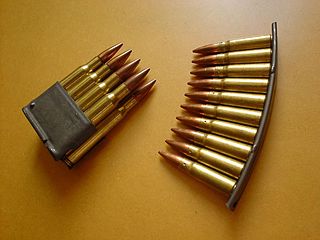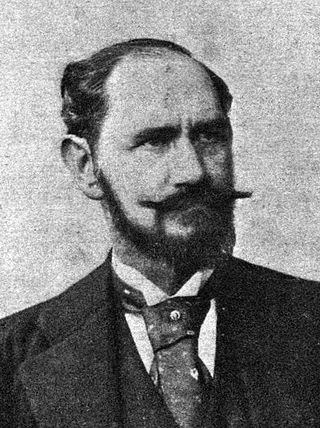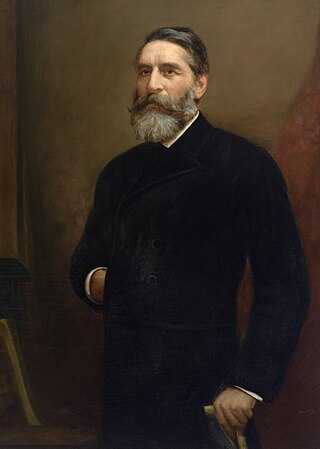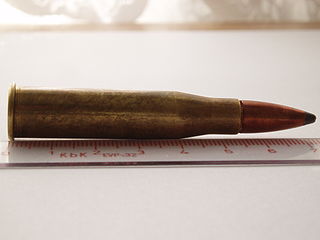A semi-automatic firearm, also called a self-loading or autoloading firearm, is a repeating firearm whose action mechanism automatically loads a following round of cartridge into the chamber and prepares it for subsequent firing, but requires the shooter to manually actuate the trigger in order to discharge each shot. Typically, this involves the weapon's action utilizing the excess energy released during the preceding shot to unlock and move the bolt, extracting and ejecting the spent cartridge case from the chamber, re-cocking the firing mechanism, and loading a new cartridge into the firing chamber, all without input from the user. To fire again, however, the user must actively release the trigger, allow it to "reset", before pulling the trigger again to fire off the next round. As a result, each trigger pull only discharges a single round from a semi-automatic weapon, as opposed to a fully automatic weapon, which will shoot continuously as long as the ammunition is replete and the trigger is kept depressed.

A clip is a device that is used to store multiple rounds of ammunition together as a unit for insertion into the magazine or cylinder of a firearm. This speeds up the process by loading the firearm with several rounds at once, rather than one at a time. There are several types, most made of inexpensive stamped sheet metal, intended to be disposable, though they are often re-used.

The Mannlicher M1895 is a straight pull bolt-action rifle, designed by Ferdinand Ritter von Mannlicher that used a refined version of his revolutionary straight-pull action bolt, much like the Mannlicher M1890 carbine. It was nicknamed the Ruck-Zuck-[Gewehr] by Austrian troops and "Ta-Pum" by Italian troops who wrote a song (it) about it during World War I. The primary producers were the ŒWG in Steyr, and FÉG in Budapest.
The Mannlicher–Schönauer is a rotary-magazine bolt-action rifle produced by Steyr Mannlicher for the Greek Army in 1903 and later used in small numbers by the Austro-Hungarian Army. Post-war it was sold for civilian use.

The Model 98a carbine was a Polish derivative of the German Gewehr 98 bolt-action rifle.

Ferdinand Ritter von Mannlicher was an Austrian engineer and small arms designer. Along with James Paris Lee, Mannlicher was particularly noted for inventing the en-bloc clip charger-loading box magazine system. Later, while making improvements to other inventors' prototype designs for rotary-feed magazines, Mannlicher, together with his protégé Otto Schönauer, patented a perfected rotary magazine design, the Mannlicher–Schönauer rifle, which was a commercial and military success.
Steyr Arms is a firearms manufacturer based in Sankt Peter in der Au, Austria. Originally part of Steyr-Daimler-Puch, it became independent when the conglomerate was broken up in 1989. Prior to 1 January 2019, the company was named Steyr Mannlicher AG. In April 2024, the company was acquired by Czech holding RSBC, which owns also Slovenian gun maker Arex Arms.

James Paris Lee was a British Canadian inventor and arms designer. He is best known for having invented the Lee Model 1879 rifle, which is the first bolt-action detachable box magazine-fed rifle. These features would be incorporated into more successful repeating rifle designs later on, such as in the Lee–Metford and Lee–Enfield rifle series.

The 6.5×50mmSR Arisaka is a semi-rimmed rifle cartridge with a 6.705 mm diameter bullet. It was the standard Japanese military cartridge from 1897 until the late 1930s for service rifles and machine guns when it was gradually replaced by the 7.7×58mm Arisaka.

The 8×50mmR Lebel rifle cartridge was the first smokeless powder cartridge to be made and adopted by any country. It was introduced by France in 1886. Formed by necking down the 11×59mmR Gras black powder cartridge, the smokeless 8mm Lebel cartridge started a revolution in military rifle ammunition. Standard 8mm Lebel military ammunition was also the first rifle ammunition to feature a spitzer boat tail bullet, which was adopted in 1898. The long-range ballistic performance of the 8mm Lebel bullet itself was exceptional for its time. For use in the magazine tube-fed early Lebel rifle, the 8 mm case was designed to protect against accidental percussion inside the tube magazine by a circular groove around the primer cup which caught the tip of the following pointed bullet. However, the shape of its rimmed bottle-necked case, having been designed for the Lebel rifle's tube magazine, also precluded truly efficient vertical stacking inside a vertical magazine. The bolt thrust of the 8mm Lebel is relatively high compared to many other service rounds used in the early 20th century. Although it was once revolutionary, the 8mm Lebel was declared obsolete after World War I and was soon after replaced with the 7.5×54mm French round.

The 8×56mmR or 8×56mmR M30S cartridge was adopted in the year 1930 by First Austrian Republic, in 1931 by the Kingdom of Hungary, and in 1934 by the Kingdom of Bulgaria as a replacement for the 8×50mmR Mannlicher cartridge.

The FÉG 35M was a bolt-action rifle chambered in 8×56mmR. Though superficially still resembling the 95/31M Carbine, it was a new design with a cock-on-close bolt. An easily recognizable distinguishing feature was the placement of the bolt handle, which was further forward than in the 1895 design. It was used by Hungary in the years leading up to and during World War II, as well as after World War II, yet was gradually phased out by both Red Army surplus, and locally produced Mosin–Nagant carbines in the years after.

The Berthier rifles and carbines were a family of bolt-action small arms in 8mm Lebel, used in the French Army, and French Colonial Forces, from the 1890s to the beginning of World War II (1940). After the introduction of the Lebel rifle in 1886, the French Army wanted a repeating carbine using the same ammunition as the Lebel to replace their single shot carbine based on the Gras rifle. At the time, many armies based their carbines on their standard rifle model, however the Lebel rifle's tube magazine made it difficult to follow this approach. The Modele 1890 Berthier Cavalry Carbine addressed this issue by combining a modified Lebel action with an en-bloc clip magazine. With its successful cavalry introduction, the Berthier would go on to be produced in many different carbine and full-length rifle versions.
The Mauser Model 1893 is a bolt-action rifle commonly referred to as the Spanish Mauser, though the model was adopted by other countries in other calibers, most notably the Ottoman Empire. The M1893 was based on the experimental M1892 rifle, which Paul Mauser developed for the Spanish Army as part of a program to correct deficiencies in the earlier 1889, 1890, and 1891 series of Mauser rifles. The M1893 introduced a short staggered-column box magazine that fit flush with the bottom of the stock; the magazine held five smokeless 7×57mm Mauser rounds, which could be reloaded quickly by pushing a stripper clip from the top of the open bolt.

Within military 8 mm firearms, the Repeating Rifle Mannlicher 1888, better known as the Mannlicher M1888, was a bolt-action rifle used by several armies from 1888 to 1945. Derived from the M1885 and later M1886 models, it was Ferdinand Mannlicher's third rifle that utilized the "en bloc clip".
The 6.5×53mmR, originally and more correctly produced as the 6.5×53.5mmR, and in imperial system nomenclature known as the .256 Mannlicher, is a late 19th-century rimmed centerfire military rifle cartridge similar to other early smokeless powder designs.

The Repeating Rifle Model 1886, commonly known as Mannlicher Model 1886, was a late 19th-century Austrian straight-pull bolt-action rifle, adopted in 1886. It used a wedge-lock straight pull action bolt. It was the first straight-pull bolt-action service rifle of any nation.

The Mannlicher M1893 is a bolt-action rifle that was the standard service rifle of the Kingdom of Romania from 1893 to 1938. The rifle and its 1892 predecessor were the first repeating rifles to be widely issued in the Romanian military. It was later replaced by the Czechoslovak-designed Vz. 24 as the standard service rifle.
The 1871 Beaumont and its variants were the service rifle of the Armed forces of the Netherlands between 1871 and 1895, and by the Royal Netherlands East Indies Army into the 1900s.




















